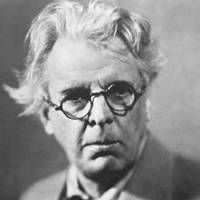Lapis Lazuli by William Butler Yeats: Introduction
Lapis Lazuli written in March 1938 is a kind of a precious blue stone. The Lapis Lazuli referred to in this poem was given to Yeats on his seventieth birthday (as a present) by Mr. Harry Clifton. Clifton had sent him a present of a great piece carved by some Chinese sculptor into a semblance of a mountain, with temple, trees, paths, and an ascetic, and a pupil about to climb the mountain.

William B. Yeats (1865-1939)
Yeats uses the carving to meditate on the role of art in an essentially tragic world.
Immediately after receiving the gift the poet began to think about its significance. Again he observed in one of his letters: “Ascetic, Pupil, hard stone, eternal theme of the sensual east”. The heroic cry in the midst of despair. But no, I am wrong, the east has its solutions always, and therefore, knows nothings of tragedy, It is we, not the east, that must raise the heroic cry. In the resulting poem the poet grappled with the problem that makes out time also restless, the destruction of civilization which may be impending. Yeats thought that the eastern people are able to tolerate the tragedies of life because they knew that sense of gaiety and tolerance are important and should be maintained even amidst tragedies and miseries.
The first stanza of the poem lists the three areas of art which, doomed to destruction, nevertheless go down to destruction gaily. The second stanza shows the gaiety inherent in tragic literature, the third stanza shows the gaiety inherent in the visual arts. Stanzas fourth and fifth show the gaiety inherent in mournful melodies. Yeats also uses stanza fifth to integrate all of the materials he has drawn on before, locating on his lapis lazuli carving the “tragic scene” of the world and a singer of “mournful melodies,” both of which induce the calm observing old Chinamen’s eyes to glitter gaily.
When Yeats planned the poem, he first saw it as an illustration of Eastern-Western difference: "Ascetic, pupil, hard stone, eternal theme of the sensual east.... the heroic cry in the midst of despair. It is we, not the east that must raise the heroic cry. "Through this East-West division was certainly in Yeats's mind when he started that poem, it seems that in the finished version his interest has shifted to a focus on the three arts facing tragedy. As a finished work it finds its theme in the conflict between art and those people of the world - hysterical women, to use his example - who would prefer action to contemplation, politics to art.
Cite this Page!
Sharma, K.N. "Lapis Lazuli by William Butler Yeats: Introduction." BachelorandMaster, 8 June 2017, bachelorandmaster.com/britishandamericanpoetry/lapis-lazuli-introduction.html.
Related Topics
The Scholars: Critical Analysis
Sailing to Byzantium: Analysis
The Theme of Immortality in Byzantium Poems
A Prayer for My Daughter: Analysis
Among School Children: Analysis
Crazy Jane Talks with the Bishop
The Lamentation of the Old Pensioner
He Wishes for the Clothes of Heaven
An Irish Airman Foresees his Death
When You Are Old: Summary and Analysis
William Butler Yeats as a Symbolist
Truth of Human Life in Yeats's Poetry
Yeats and the Romantic Tradition
The Salient Features of Yeats's Poetry
Biography of William Butler Yeats
 |
bachelorandmaster.com |